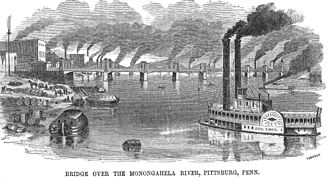Monongahela River
Monongahela River
The Monongahela River, often referred to simply as the Mon, is a significant river located in the United States, flowing through the states of West Virginia and Pennsylvania. It is a major tributary of the Ohio River, joining it at the Point State Park in Pittsburgh, Pennsylvania. The river is approximately 130 miles (210 km) long and plays a crucial role in the region's economy, history, and environment.
Course
The Monongahela River originates from the confluence of the West Fork River and the Tygart Valley River in Fairmont, West Virginia. From there, it flows north, winding through the Appalachian Mountains and the coal-rich regions of West Virginia and Pennsylvania. The river's course takes it past several important towns and cities, including Morgantown, West Virginia, home to West Virginia University, and into Pennsylvania, passing through Greensburg and McKeesport, before reaching Pittsburgh.
History
The Monongahela River's history is deeply intertwined with the industrial development of the United States. In the 19th and early 20th centuries, the river was a vital transportation route for coal, steel, and other materials that fueled the nation's industrial growth. The construction of locks and dams, starting in the 19th century, made the river navigable year-round, further enhancing its economic significance.
The river also played a key role in the early military history of the country. During the French and Indian War, the Battle of the Monongahela was a significant conflict that took place near the river's banks.
Ecology
The Monongahela River's ecosystem supports a diverse range of flora and fauna. Efforts have been made to improve the river's water quality, which had been adversely affected by industrial pollution and mining activities. These initiatives have led to a resurgence in the river's fish populations and have made it a popular location for recreational fishing, boating, and wildlife observation.
Recreation
Today, the Monongahela River is a hub for recreation and tourism. The river's banks are lined with parks, walking trails, and historic sites that attract visitors from across the region. Boating, kayaking, and fishing are popular activities, with several marinas and boat launches providing access to the water.
Economic Impact
The Monongahela River continues to be an economic asset for the region. While its role in transporting coal has diminished, the river supports commercial navigation, recreational tourism, and contributes to the local economies of the communities along its banks.
Conservation
Conservation efforts along the Monongahela River focus on maintaining the water quality and preserving the natural habitats found along its course. These efforts are crucial for ensuring the health of the river's ecosystem and the well-being of the communities that depend on it.
See Also
Transform your life with W8MD's budget GLP-1 injections from $125.
W8MD offers a medical weight loss program to lose weight in Philadelphia. Our physician-supervised medical weight loss provides:
- Most insurances accepted or discounted self-pay rates. We will obtain insurance prior authorizations if needed.
- Generic GLP1 weight loss injections from $125 for the starting dose.
- Also offer prescription weight loss medications including Phentermine, Qsymia, Diethylpropion, Contrave etc.
NYC weight loss doctor appointments
Start your NYC weight loss journey today at our NYC medical weight loss and Philadelphia medical weight loss clinics.
- Call 718-946-5500 to lose weight in NYC or for medical weight loss in Philadelphia 215-676-2334.
- Tags:NYC medical weight loss, Philadelphia lose weight Zepbound NYC, Budget GLP1 weight loss injections, Wegovy Philadelphia, Wegovy NYC, Philadelphia medical weight loss, Brookly weight loss and Wegovy NYC
|
WikiMD's Wellness Encyclopedia |
| Let Food Be Thy Medicine Medicine Thy Food - Hippocrates |
Medical Disclaimer: WikiMD is not a substitute for professional medical advice. The information on WikiMD is provided as an information resource only, may be incorrect, outdated or misleading, and is not to be used or relied on for any diagnostic or treatment purposes. Please consult your health care provider before making any healthcare decisions or for guidance about a specific medical condition. WikiMD expressly disclaims responsibility, and shall have no liability, for any damages, loss, injury, or liability whatsoever suffered as a result of your reliance on the information contained in this site. By visiting this site you agree to the foregoing terms and conditions, which may from time to time be changed or supplemented by WikiMD. If you do not agree to the foregoing terms and conditions, you should not enter or use this site. See full disclaimer.
Credits:Most images are courtesy of Wikimedia commons, and templates, categories Wikipedia, licensed under CC BY SA or similar.
Contributors: Prab R. Tumpati, MD





